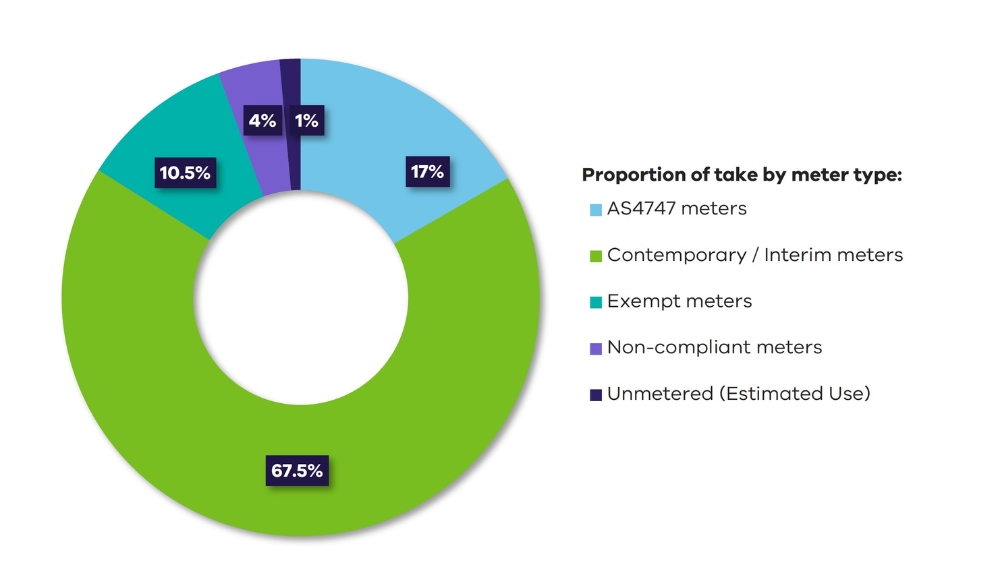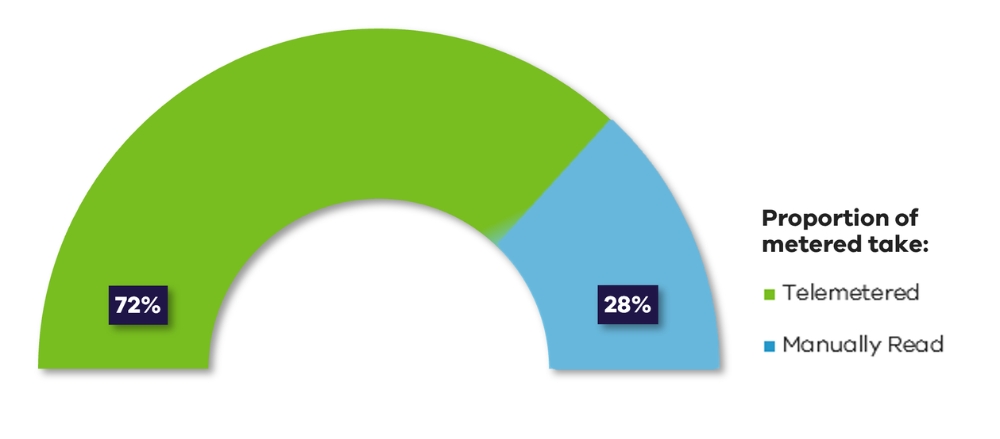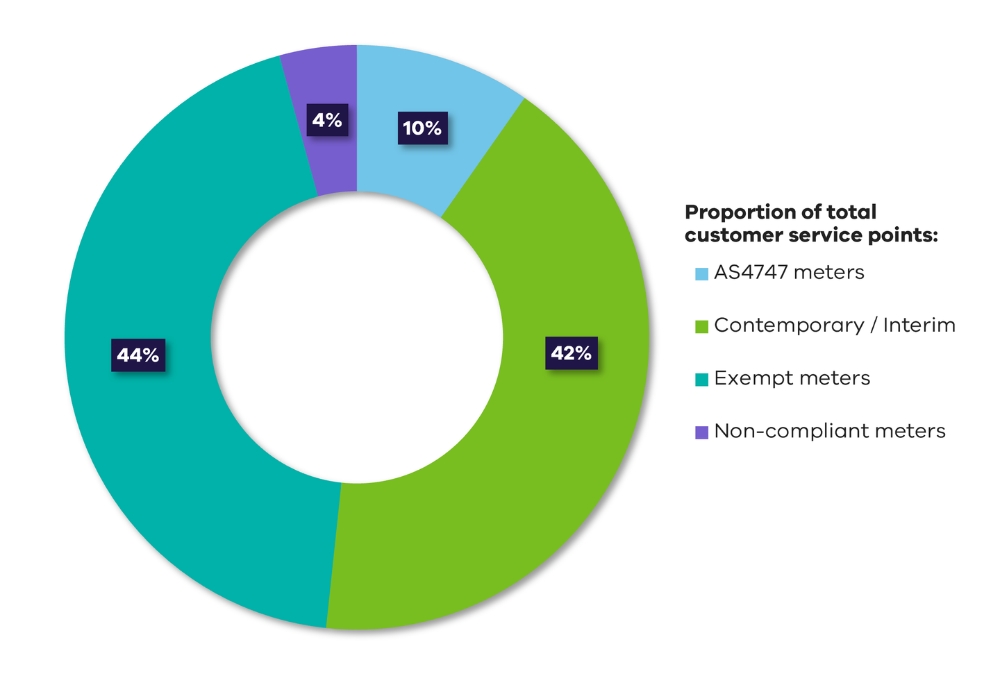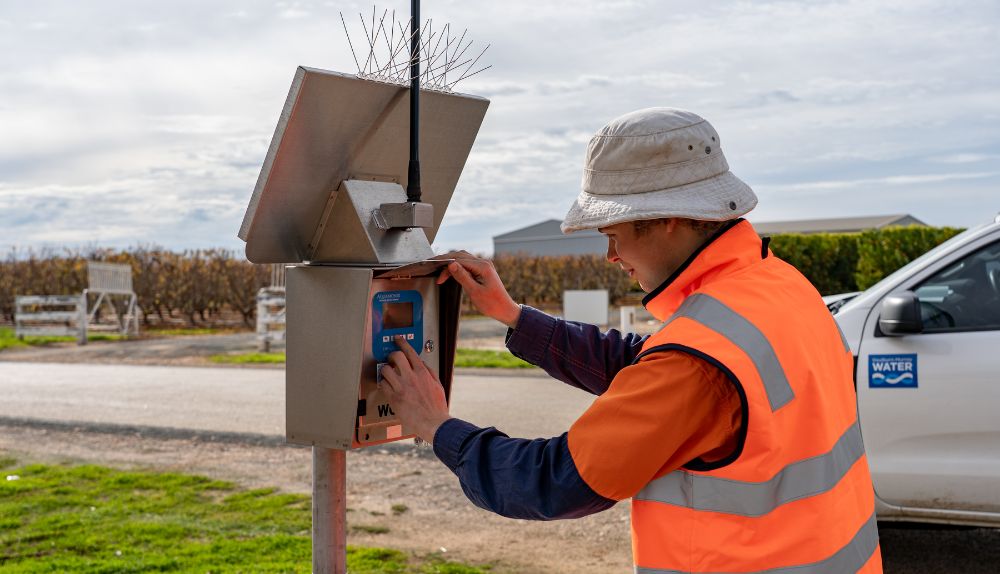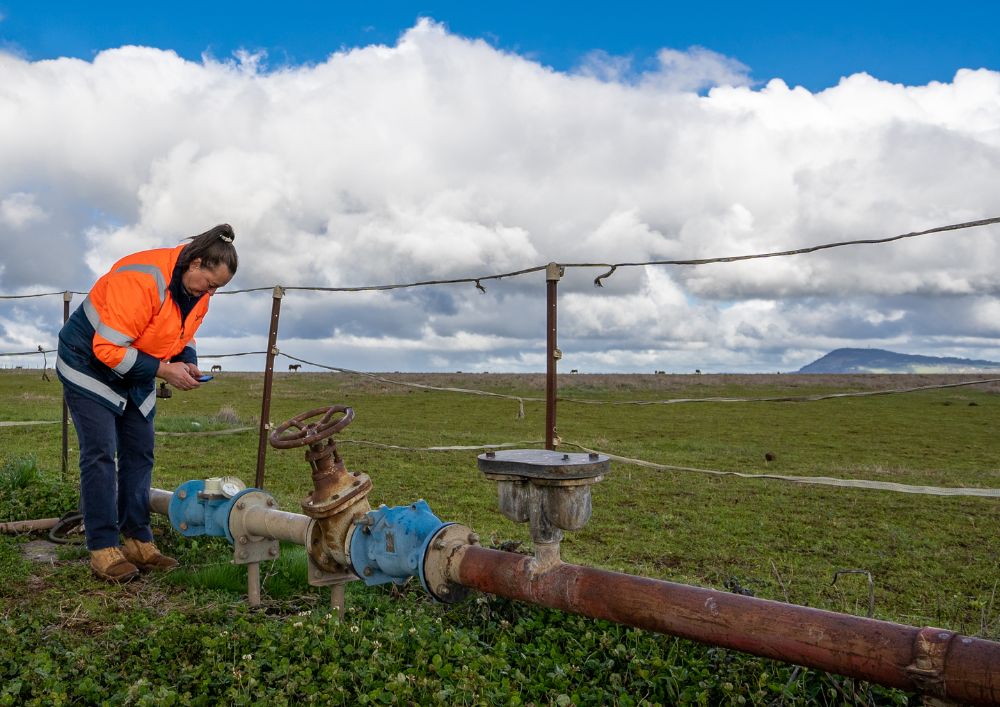On this page:
Non-urban metering is essential for comprehensive water accounting and sustainable water management. Victoria is committed to the effective measurement of non-urban water users’ diversions (metering take).
This report meets Victoria’s continuing obligation to monitor and report on Victoria’s progress in implementing non-urban water metering. All previous metering implementation reports are available and can be found on the Murray-Darling Basin Compliance webpage.
- Victoria’s non-urban water metering policy (PDF, 817.4 KB), in accordance with the Murray-Darling Basin Compliance Compact (2018) sets requirements for water corporations and their rural customers to prepare and maintain metering action plans.
- In 2023-24, Victorian water corporations implemented metering action plans to deliver high-quality metering services to Victorian non-urban water users.
Victoria’s Non-Urban Water Metering Policy
In 2023-24, DEECA and water corporations finalised the review of the Victorian non-urban water metering policy and associated metering action plan guidelines. Confirming alignment with the Metrological Assurance Framework (MAF2 2021) for non-urban water meters. The revised policy will be published and available later online in 2024.
Victorian water corporations own and maintain meters and are responsible for manually reading meters where telemetry is not available. Victoria’s metering policy requires water corporations to read meters at least once a year for low volume-risk meters, more frequently for higher-risk volumes and at least twice a year for surface water winter-fill licences or where there is a history of usage breaches.
Non-urban water metering systems and assets
Victorian water corporations are early adopters of non-urban water metering and national leaders in telemetry and automated control systems.
Metering terminology used within this report is defined on Non-urban water metering reports.
In 2023-24, 99% of total water taken via customer service points across Victoria was metered.
In 2023-24, 1% of water take was estimated (down from 2% in 2022-23), where a service point may not be metered. Water corporations can vary meter requirements in certain circumstances. A metering rule can be varied where:
- risks are manageable, including where adequate water measurement is provided by bulk water metering
- costs outweigh benefit (i.e., small volume take for domestic and stock purposes)
- the site requires the application of hydrometric monitoring standards.
Telemetry uplift in Victoria
Victoria has been an early adopter of telemetry and automated control systems. Telemetry attached to meters ensures the water corporation knows in real-time when water users take more water than they are entitled to take.
As of 30 June 2024, of Victoria’s 51,117 meters:
- 60% are fitted with telemetry across Victoria, a slight increase from 2022-23.
- 62% of meters are telemetered across Northern Victoria, remaining consistent with 2022-23.
In Victoria, a high proportion of total water taken is monitored through telemetry devices. Telemetry allows real-time monitoring of high-volume users and sends data electronically to water corporations.
In 2023-24:
- 72% of water taken through a meter was telemetered, and 28% was manually read by water corporation staff. Meters were manually read 50,660 times state-wide or 44,856 in Northern Victoria.
- 71% of total water taken in Victoria was telemetered, down from 74% in 2022-23.
- 72% of total water taken in Northern Victoria was telemetered, down from 76% in 2022-23.
Victoria continues to invest in installing telemetry on meters to enhance monitoring of water take:
- water corporations fitted 235 new telemetry devices to meters in 2023-24
- Victoria is seeking funding through the Commonwealth’s Murray-Darling Basin Telemetry Uplift Program to install new telemetry devices in Northern Victoria.
Metering and telemetry in Victoria 2019-2024
Note:
- In 2020–21, the number of meters reported included small volume domestic and stock customers where exemptions for metering apply, and usage is deemed.
- In 2023-24, water corporations continued to improve their reporting systems and decommissioned sites resulting in an observed reduction in metered sites across the state.
Meter accuracy in Victoria
The National Measurement Institute approved the first meter for full flowing pipes as conforming with the AS4747 standard (pattern-approved) in 2014. The majority of meters in Victoria were installed before 2014, which means meters that conform with AS4747 make up a relatively smaller portion of Victoria’s metering fleet (10%).
The number of meters that conform with AS4747 will increase over time through the replacement of non-compliant meters and meters at the end of their operational life. The Non-urban water meters conforming to AS4747 (pattern-approved) document provides more information.
In 2023-24:
- 84.5% of total water take was measured via meters across Victoria that conform with AS4747 or contemporary standards accurate to ±5 % target accuracy set by the National framework for Non-urban metering (2009)
- 17% of take across Victoria was measured via meters that conform with AS4747 standards.
DEECA and water corporations are working to increase the uptake of more AS4747 meters and telemetry. All water corporations have metering action plans, that set out:
- when and where new meters and telemetry will be installed
- when and where non-compliant meters will be replaced, and
- fitting telemetry to metered water take, where the benefits of stronger compliance outweigh costs.
Since the review of the Victorian non-urban metering policy in March 2020, the number of meters that conform with AS4747 has increased across the state and in Northern Victoria. As of 30 June 2024, 10% of meters (or 4,982 meters) conform with AS4747 standards across Victoria.
As of 30 June 2024, 4% of meters (or 2,189 meters) in Victoria are non-compliant and require an accurate meter to conform with AS4747.
Most meters in Victoria are a contemporary standard (±5 % target accuracy) or are exempt from metering upgrade requirements (e.g., small volume take, domestic and stock use). Victoria is committed to effective measurement of non-urban water take.
Victorian water corporations have detailed a risk-based approach to AS4747 upgrade requirements within their metering action plans to install by June 2025 in order to meet Murray-Darling Basin Compliance Compact obligations.
Number of meters that conform to AS4747 in Victoria and Northern Victoria between 2020-21 and 2023-24
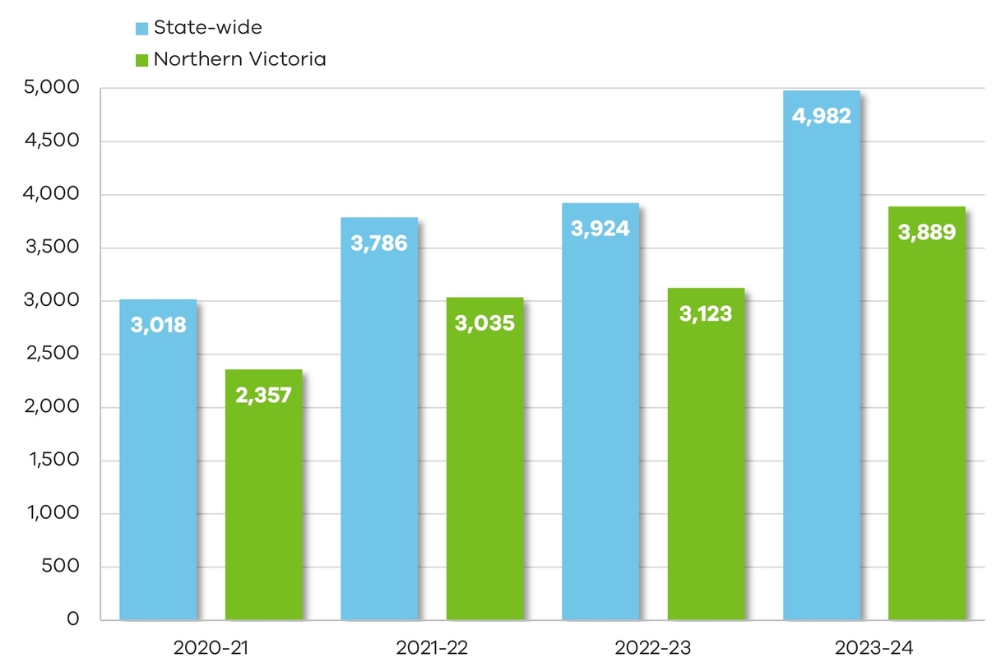
Bulk water metering in Victoria
Water corporations are granted bulk entitlements by the Minister for Water. The entitlements provide the right to take, store and use water subject to specified conditions and obligations.
Water corporations have bulk entitlement metering programs aligned to the Minister’s Guidelines for bulk entitlement metering programs publicly disclose take under bulk entitlements in annual reports tabled in Parliament and in the Victorian Water Accounts.
Metering and compliance in 2023-24
The Victorian Government has a zero-tolerance approach to unauthorised take. As well as accurate meters, other important components of metering that enable effective compliance and enforcement are:
- meters are read, inspected, and maintained by water corporation staff
- 71% of customers’ take is telemetered. This means water corporations receive data electronically at a close to real time frequency. This can be used by water corporations to monitor and enforce compliance more regularly
- bulk water measurement facilitates accounting and has a high level of public disclosure via published annual water accounts and water corporation annual reports that are tabled in parliament; and
- automated control systems in many modernised irrigation districts give water corporations accurate information about deliveries and losses. This prevents people from ordering more water than they are authorised to take.
In 2023-24, meters were manually read 69,226 times in Northern Victoria, and 80,832 times state-wide by water corporation staff. These numbers include inspections related to compliance and meter maintenance.
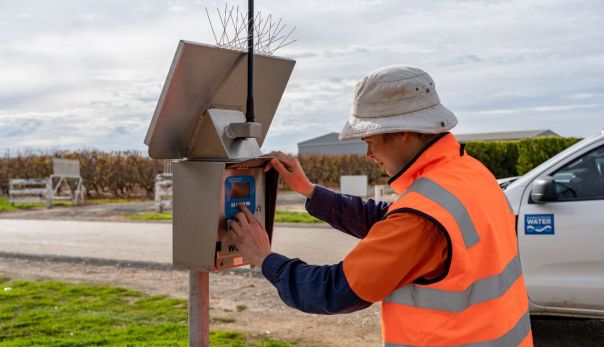
- Telemetry device reading

- Southern Rural Water field officer inspects water monitoring technology
Victoria as part of the Murray-Darling Basin
The Inspector-General of Water Compliance publishes an annual Metering Report Card to track progress of metering reform in the Murray-Darling Basin. The report continues to show Victoria as a leader in non-urban metering and telemetry. In 2023-24, Victoria reported more meters than all other jurisdictions combined.
All previous IGWC Metering report cards can be found on the Inspector General’s website.
Non-urban water metering priorities in 2024-25
DEECA and water corporations will continue to implement actions from the state policy and metering action plans, including:
- DEECA will support water corporations to update their metering action plans to align with the updated Victorian non-urban water metering policy and guidelines and the requirements of the Metrological Assurance Framework (MAF2).
- Metering coordinators from water corporations with rural customers will share information on meter and telemetry performance, implementing the policy, and improving metering practice. DEECA and water corporations will review the implementation of metering action plans against 2025 policy targets.
- Water corporations will assess the costs and benefits of installing telemetry on meters that are still being read manually and update their metering action plans. DEECA will continue to oversee the telemetry acceleration program in Goulburn-Murray Water’s Zone 7 customer base.
- DEECA and water corporations will continue a review of Unmetered Rural Water Take Measurement Methodology to accurately calculate unmetered/deemed rural water use for customer billing, compliance, and water resource management purposes.
Page last updated: 14/01/25

